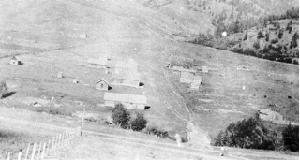
![]()

One account about Bolster said there were up to 90 buildings, all log except for the hotel
The early day boom town of Bolster was located within sight of the Canadian border. Bolster started in a mining flurry when the area was opened to mineral entry in 1896. Bolster was platted in 1899 by J.W.McBride. There were three stores, post office, assay office, newspaper called "The Bolster Drill," several saloons, Doctor Beale’s office, and a three-story hotel. The boom collapsed in 1900 and the business life was of short duration.
By 1904 Bolster was practically deserted, but the post office remained until 1909. Today it would hard to tell, as one drives by the old Bolster site, that there had ever been a population of 200 or 300 souls.
As one drives toward the Canadian boundary two miles north of Chesaw, three old weather-beaten buildings of a pioneer type may be seen standing in a field near the Pickering modern farm home. A casual visitor to this peaceful, quiet area might mistake them for abandoned homesteaders' shacks, little suspecting that they mark the main street where the gay, bustling town of Bolster once stood.
In 1900 miners' picks and drills were active on both sides of this Myers Creek Valley, eventually stirring up considerable excitement at such properties as the nearby Gray Eagle and Tico mines.
Bolster's growth was rapid although its business life was of short duration. For a time it laid claim to being the metropolis of the "Myers Creek Mining District." It embraced the entire plateau now commonly referred to as the Molson Chesaw district. With its stores, assay offices, adequate supply of saloons, a three-story frame hotel and newspaper, Bolster in 1900 gave promise of becoming a large town. Its newspaper was the Bolster Drill and was published for one year from June 1900 to June 10, 1901, with D.C. Jenkins as editor.
The history of early day newspapers of the upper country is that of the pioneer printers and publishers, the courageous ones who came when there was little to live on, but much to live for.
When trail-blazing town-builders platted a parcel of ground, drove their stakes, posted a sign and said, "This is where the town will be," the very first man to put in an appearance was a printer.
Arriving with a gunnysack full of type and a battered-up press or two, he took out his jack knife, sharpened a wooden pencil stud, hacked off a chaw of "Old Horseshoe" and he was in business! A newspaper was born!
Many such ventures died at birth, even in a good town. Others in a mighty small burg made a go of it. As a rule, communities and their little newspaper rose and fell together. Launching a weekly newspaper was more or less a gamble.
The Bolster Drill died in its infancy, as did many others. Morally and financially backed by John McBride, mine and townsite promoter, The Drill was edited by Dan Jenkins. Dan was son of W.D. Jenkins, then Washington's Secretary of State. The elder Jenkins was also connected with both the Reveille and Herald, published at Bellingham, Washington. There was nothing to support a paper at Bolster and demise was inevitable. The plant reverted to McBride, godfather of Bolster. Later much of The Drill's equipment was bought by Fred Fine and used in starting the Oroville Gazette.
Bolster boasted of a "Board of Trade" and also the Bolster Improvement Company. An advertisement of the latter institution stated: "Bolster has made a growth since October 1899 that no other town in Washington can show. From an Indian village of two log huts, in less than one year's time, over 90 substantial buildings now adorn the flat."
By 1900 Chesaw and Molson had been started and a town at Kipling had been planned. With the demise of Bolster Drill, publication of Myers Creek News at Chesaw began in February 1902.
My first view of Bolster was on a cold December night in 1916. I had been met at the railway station at Myncaster, B.C. about two miles north of Bolster by J.B. Jones, Chesaw banker. As we rode up the valley behind a fine team of horses in an attractive black sleigh, I suddenly saw many lights from kerosene lamps shining from windows. I asked for the name of the town we were approaching, thinking that perhaps it was Chesaw, where I was informed I had obtained a position as teacher. Then I was informed that it was the town of Bolster. A number of people still lived there but no business houses had been operated there for a number of years.
About the author: Frank Emert, now deceased, was for many years the publisher of the Omak Chronicle. The above article was written many years ago and was taken from files of his newspaper.
![]()
